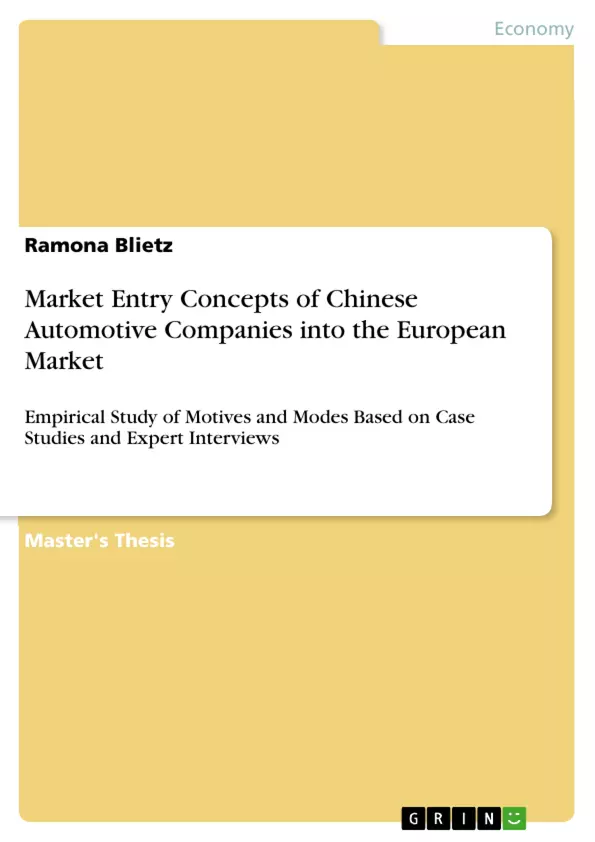This paper investigates Chinese automotive companies’ internationalisation activities into the European market. They are still short on experience and young in history. Since the Chinese economy has only gradually liberalised after 1978, the industry has been highly influenced by joint venture activities with foreign automobile companies in China.12 years ago, Chinese automotive companies started to internationalise. Dunning’s eclectic paradigm is utilized as academic foundation and related motives and entry modes are aligned to current Chinese activities. In early attempts to enter Europe there was a predominant resource-seeking motive, while later market-seeking reasons became more obvious and have dominated the activities since.
So far, ownership-specific advantages do not play a major role in terms of valuable intangible assets like patents, whereas location specific determinants are significant, especially in terms of governmental impact. Additional home market advantages in labour endowment, resources, legal environment and strong finan- cial resources give Chinese automakers an edge and prepare them to further internationalise. However, regarding all OLI forces, there are still no outweighing advantages over European competitors. The interviewed experts do not expect a noticeable market entry with significant sales volume within the next ten years. To date, Chinese exports and FDI in Europe are the most relevant modes even though visibility is marginal. According to industry experts, companies like Qoros, BYD and Geely are possible candidates to succeed on the European market in the future. Other brands, which failed to enter Europe, e.g. due to lacking safety standards, are yet still opinion-forming.
It is concluded, that if China’s automotive industry consolidates and advances technologically, it will be prepared to successfully compete on global markets, in particular Europe. The acquisition of European car manufacturers represent – in this context – a feasible possibility to speed up the process and offset technological deficiencies.
Inhaltsverzeichnis (Table of Contents)
- 1. INTRODUCTION
- 2. LITERATURE REVIEW
- 2.1. Explanations of international activities
- 2.2. Competitive advantages according to Dunning's OLI paradigm
- 2.3. Weaknesses and extensions of the eclectic paradigm
- 2.4. Internationalisation motives
- 2.5. Market entry modes
- 2.5.1. Exports
- 2.5.2. Foreign direct investment
- 3. METHODOLOGY
- 4. EMPIRICAL STUDY OF CHINESE AUTOMOTIVE COMPANIES' INTERNATIONALISATION
- 4.1. Introduction to regions and industry dynamics
- 4.1.1. China
- 4.1.1.1. OFDI development and motives
- 4.1.1.2. Preconditions on home market
- 4.1.1.3. Domestic automotive industry
- 4.1.2. Europe
- 4.1.1. China
- 4.2. Company case studies of BYD, Geely and SAIC
- 4.2.1. Competitive advantages of Chinese automotive companies
- 4.2.2. Reasons of Chinese automotive companies to venture abroad
- 4.2.3. Dominant market entry modes
- 4.2.3.1. Exports
- 4.2.3.2. Foreign direct investment
- 4.2.4. Obstacles and entry barriers
- 4.3. Conclusion
- 4.1. Introduction to regions and industry dynamics
Zielsetzung und Themenschwerpunkte (Objectives and Key Themes)
This master's thesis examines the market entry strategies of Chinese automotive companies into the European market. The study investigates the motives behind these international activities and analyzes the chosen market entry modes, utilizing case studies and expert interviews.
- Understanding the factors driving Chinese automotive companies' internationalization.
- Exploring the competitive advantages and challenges faced by Chinese companies in the European market.
- Analyzing the various market entry modes employed by Chinese automotive companies, including exports and foreign direct investment.
- Identifying the key obstacles and entry barriers encountered by Chinese companies in the European market.
- Drawing conclusions about the future prospects of Chinese automotive companies in the European market.
Zusammenfassung der Kapitel (Chapter Summaries)
- Introduction: This chapter provides an overview of the research topic, outlines the research questions, and introduces the methodology used in the study. It also discusses the significance of the research and its contribution to the existing literature.
- Literature Review: This chapter reviews the relevant literature on internationalization, competitive advantages, and market entry modes. It focuses on the theories and frameworks that provide a theoretical foundation for the empirical study. Specifically, it examines Dunning's OLI paradigm and its extensions, highlighting the importance of ownership, location, and internalization advantages in explaining international activities.
- Methodology: This chapter describes the research methodology used in the study, including the data collection methods, the selection of case studies, and the analysis techniques employed. It also discusses the limitations of the study and the measures taken to mitigate them.
- Empirical Study of Chinese Automotive Companies' Internationalization: This chapter presents the findings of the empirical study, which focuses on the internationalization strategies of three major Chinese automotive companies: BYD, Geely, and SAIC. It analyzes their competitive advantages, motives for venturing abroad, chosen market entry modes, and the obstacles they encounter. The chapter also provides insights into the dynamics of the Chinese and European automotive industries.
Schlüsselwörter (Keywords)
This study focuses on the internationalization of Chinese automotive companies, particularly their market entry strategies in Europe. Key concepts include outward foreign direct investment (OFDI), competitive advantages, market entry modes, and the challenges faced by Chinese companies in the European market. The study utilizes frameworks such as Dunning's OLI paradigm and provides insights into the dynamics of the Chinese and European automotive industries.
- Quote paper
- Ramona Blietz (Author), 2015, Market Entry Concepts of Chinese Automotive Companies into the European Market, Munich, GRIN Verlag, https://www.grin.com/document/319841



